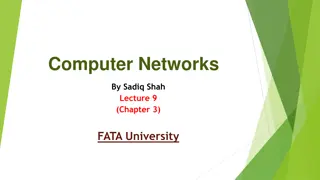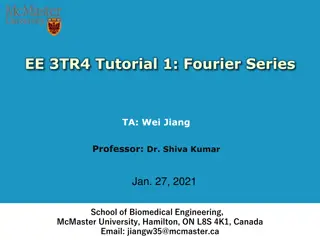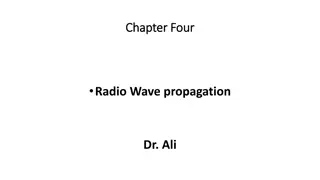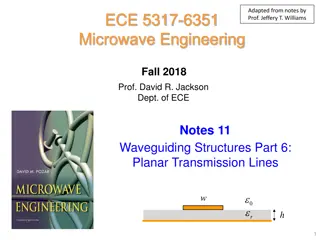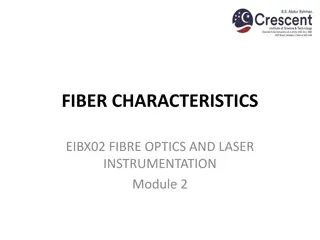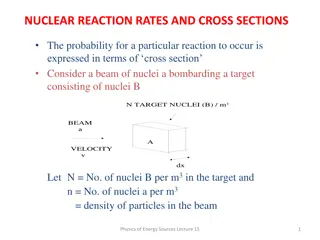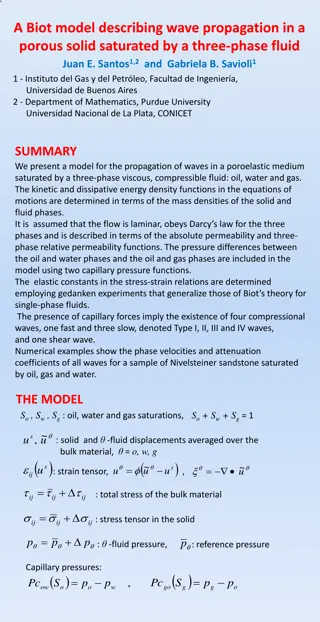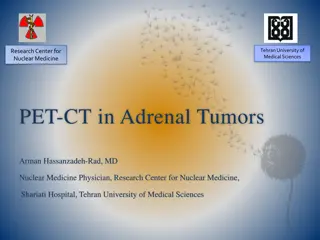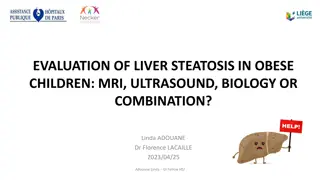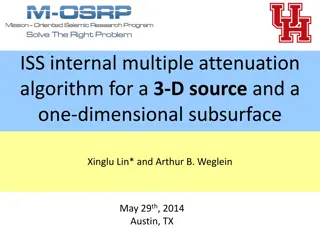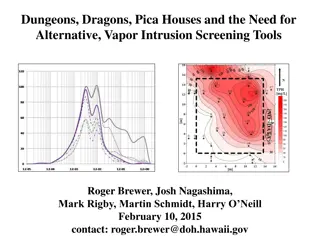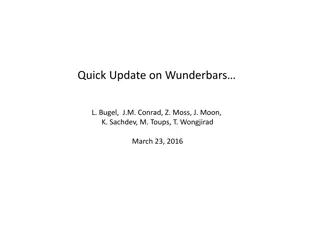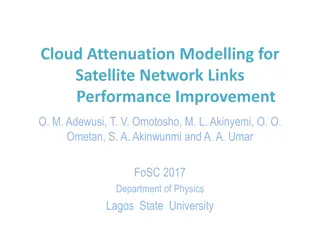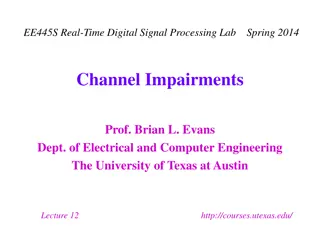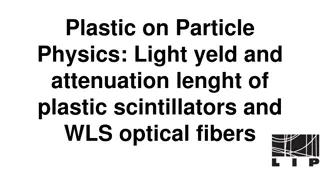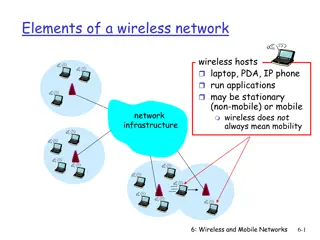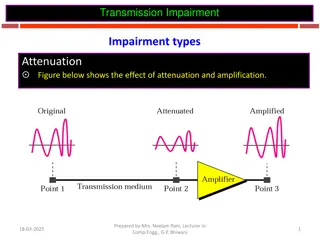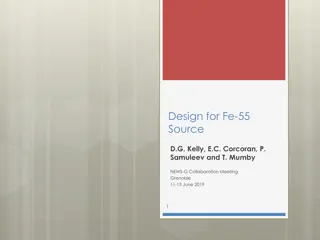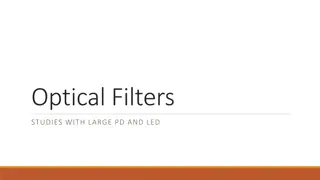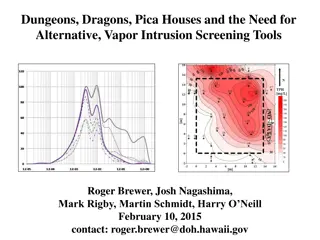Radar Attenuation Tomography for Mapping Englacial Temperature Distributions
Radar Attenuation Tomography is used to map the temperature distributions within the ice sheet by analyzing the radio waves' attenuation properties. This study focuses on the Eastern Shear Margin of Thwaites Glacier, where fast-moving ice meets slower ice, impacting ice rheology influenced by temper
5 views • 18 slides
Optical Fiber Signal Degradation in Communication Engineering
Technocrats Institute of Technology (Excellence) in Bhopal delves into the concepts of signal degradation in optical fiber communication, focusing on attenuation, distortion mechanisms, and measurement techniques. The institute emphasizes the importance of signal attenuation and its impact on inform
6 views • 56 slides
Transmission Impairments in Computer Networks
Signals traveling through transmission media in computer networks can experience attenuation, distortion, and noise, leading to signal loss and changes in form or shape. Attenuation results in energy loss requiring amplification, while distortion alters the signal's composition. Engineers use decibe
1 views • 12 slides
Designing Low-Pass Filter for Square Wave Harmonic Suppression
This tutorial discusses the design of a low-pass filter to suppress harmonics in the output of a square wave signal. The goal is to achieve at least 32 dB attenuation of any harmonics relative to the fundamental sinusoid at 5 kHz. The solution involves analyzing the square wave, determining the nece
1 views • 18 slides
Radio Wave Propagation in the Ionosphere
Radio wave propagation in the ionosphere is influenced by factors such as the radio refractive index and absorption of radio wave energy. This chapter delves into the interaction of radio waves with the ionosphere, discussing concepts like the electromagnetic spectrum nomenclature and the frequency
1 views • 15 slides
Enhancing Privacy in Crowdsourced Spectrum Allocation
This research focuses on protecting privacy in crowdsourced spectrum allocation, addressing the security challenges faced due to the presence of multiple entities and the sensitive information collected. By proposing potential ideas like Fully Homomorphic Encryption (FHE) and Secure Multi-Party Comp
1 views • 26 slides
Overview of Planar Transmission Lines in Microwave Engineering
This document details various types of planar transmission lines such as microstrip, stripline, coplanar waveguide, and slotline used in microwave engineering. It covers the characteristics, field structures for TEM mode, analysis methods, conformal mapping solutions, and considerations for effectiv
3 views • 25 slides
Fiber Characteristics in Fiber Optics and Laser Instrumentation
This module explores the mechanical characteristics such as strength, static fatigue, and dynamic fatigue of glass fibers in fiber optics. It discusses the cohesive bond strength of glass fibers, static fatigue under humid conditions, and dynamic fatigue during installation and operation. The transm
1 views • 34 slides
Nuclear Reaction Rates and Cross Sections
Nuclear reaction rates and cross sections play a crucial role in determining the probability of interactions between particle beams and target nuclei. Cross section is the effective area of a target nucleon to the incident beam, with the interaction probability calculated based on the number density
2 views • 13 slides
General Plane Waves in Electromagnetic Theory
This study focuses on the analysis of general plane waves in electromagnetic theory, covering topics such as the general form of plane waves, Helmholtz equation, separation equation, wavenumber vector, Maxwell's equations for plane waves, and the symbolic representation of plane waves. The content d
0 views • 41 slides
Model for Wave Propagation in Poroelastic Medium Saturated by Three-Phase Fluid
We introduce a model describing wave propagation in a porous solid saturated by a three-phase fluid (oil, water, and gas). The model considers kinetic and dissipative energy density functions, laminar flow obeying Darcy's law, and capillary pressure functions. Elastic constants are determined using
1 views • 4 slides
Biases in Measurement of Thoughts, Feelings, and Behaviors: Current Research Insights
Current research explores biases in measuring thoughts, feelings, and behaviors, focusing on the attenuation effect observed in subsequent reports. This effect, illustrated through various studies and examples, highlights a decrease in reported symptoms over time, potentially influenced by measureme
1 views • 41 slides
Proposal of TG3d Channel Model for Wireless Backhaul/Fronthaul in IEEE 802.15 Working Group
This document presents a proposal for a TG3d channel model intended for wireless backhaul/fronthaul applications within the IEEE 802.15 Working Group. The proposal addresses operational characteristics, including high path loss mitigation at 300 GHz, requiring high gain antennas for LOS connections.
0 views • 20 slides
Analysis of Resolution Study and Charge Scans on 17th Feb 2017
Detailed analysis conducted on 17th Feb 2017 includes resolution calculations, charge scans, attenuation comparisons, and improvements in data fitting. The study compares measured resolutions with predicted scaling, examines the impact of additional information on fitting, and explores peak shifts i
0 views • 30 slides
PET-CT Imaging in Adrenal Tumors at Tehran University
Tehran University of Medical Sciences' Research Center for Nuclear Medicine specializes in PET-CT imaging for adrenal tumors. Dr. Arman Hassanzadeh-Rad, MD, explains the principles of PET imaging, hybrid imaging combining PET and CT, F-18 FDG use, SUV measurement, and more. PET-CT allows for both at
0 views • 21 slides
Prediction of Liver Fibrosis in NAFLD Patients: Impact of CAP Values
Steatosis has emerged as a significant diagnosis with NAFLD becoming a common cause for hepatologic evaluation. Liver stiffness measurement (LSM) using transient elastography is vital for assessing fibrosis severity in NAFLD patients. However, the accuracy of LSM can be influenced by obesity and sev
0 views • 35 slides
Design Principles for Water Reclamation and Reuse
Achieving consistent reclaimed water quality requires proper treatment strategies, technical controls, online monitoring, and operational controls. The design principles focus on elements like monitoring, attenuation, retention, and blending to ensure water quality for various reuse applications. Wa
0 views • 22 slides
Evaluation Methods for Liver Steatosis in Obese Children
This study examines the assessment of liver steatosis in obese children using MRI, ultrasound, and biology techniques, evaluating methods such as attenuation coefficient and proton density fat fraction. The aim is to develop noninvasive biomarkers and validate existing scores for predicting NAFLD. P
0 views • 22 slides
Enhanced Algorithm for Internal Multiple Attenuation in Seismic Imaging
This research discusses the development of an improved algorithm for internal multiple attenuation in seismic imaging. The focus is on addressing the challenges in onshore and offshore regions close to a 1-D earth model. The algorithm aims to enhance the efficiency and accuracy of data processing in
0 views • 61 slides
Designing Quality Copper Products: The Manufacturing Process
Delve into the intricate process of designing and manufacturing copper products with a focus on quality. Understand testing requirements for various category levels and learn how OCC products are meticulously crafted to meet these standards. Explore the key parameters and technical aspects of Catego
0 views • 35 slides
Alternative Vapor Intrusion Screening Tools for Environmental Investigations
Estimation of subslab attenuation factors for vapor intrusion investigations is crucial in assessing indoor air quality. This study reviews EPA methods, emphasizing the importance of vapor attenuation in screening indoor air for contaminants. Various experts contributed insights, leading to the deve
0 views • 35 slides
Optimization of Wunderbar Production Process
Mitigating factors contributing to wunderbar-making issues, a transition to using a dipping machine, and data analysis for coating effectiveness were discussed. Experiments on different gas fills, control of coating thickness, humidity effects, and plans for future lightguide production were highlig
1 views • 6 slides
Innovative Solutions for Cryogenic Suspensions Using Compressive Flexure Beams
Test mass cryogenic suspensions with rigid beams pose conflicting requirements, such as thermal noise reduction and vibration attenuation. This study explores the use of compressive flexure beams as a solution to achieve flexibility without sacrificing thermal conductance. Compressional mode flexure
0 views • 13 slides
Enhancing Satellite Network Links Performance through Cloud Attenuation Modelling
This paper discusses the impact of cloud attenuation on satellite network links in tropical regions like southwest Nigeria with high cloud cover percentages. The study focuses on improving satellite communication system design and operation by analyzing cloud effects and proposing modelling techniqu
2 views • 39 slides
Impairments in Wireline Communication Channels
Wireline communication channels can experience various impairments such as linear time-invariant effects like attenuation and spreading, as well as linear time-varying effects like phase jitter, nonlinear effects, additive noise, and interference. These impairments can affect the quality of transmit
1 views • 16 slides
LAN Hardware Components and Connectivity Mediums
LAN hardware components, such as cables, repeaters, hubs, switches, and network interface cards, play a crucial role in transmitting electric signals between devices. Cables are the primary connectivity medium, with factors like bandwidth and distance affecting data transmission. External disturbanc
0 views • 26 slides
Silicon X-ray Absorption and Considerations for APS Run
This presentation by Bruce Schumm at the UC Santa Cruz meeting discusses the basic principles of silicon X-ray absorption, including overall attenuation length, Compton fraction, and considerations for an APS run. It covers inputs for modeling X-ray absorption, photon cross sections, attenuation coe
0 views • 14 slides
Thursday Case of the Day
A case study investigates a PET/CT artifact caused by misregistration between PET and CT images due to rectum gas motion, leading to attenuation correction errors. Experimental evidence and images illustrate this phenomenon.
0 views • 4 slides
The Electromagnetic Spectrum
Encompassing various types of EM radiation, the electromagnetic spectrum spans from visible light to gamma-rays. Explore the roles of different radiation types, from radio waves to X-rays, in our daily lives and beyond. Delve into the laws of transmission, including reflection, refraction, absorptio
0 views • 20 slides
Light Yield & Attenuation in Plastic Scintillators & Optical Fibers
Unveil the light yield and attenuation characteristics of plastic scintillators and WLS optical fibers in particle physics research. Explore sources of damage, photodetectors, measurements with radioactive sources, and apparatus views. Dive into detailed analyses and comparisons of light intensities
0 views • 16 slides
Computer Network Reliability and Channel Coding
Communication systems are prone to errors due to various factors like interference, distortion, and attenuation. Explore ways to reduce errors, the impact of transmission errors on data, and techniques like error control and correction through channel coding for enhanced reliability.
0 views • 22 slides
Elements of a Wireless Network and Link Characteristics
Explore the elements of a wireless network including wireless hosts, base stations, and wireless links. Understand the differences between mobile and stationary wireless devices, base stations' role in relaying data between wired and wireless networks, and the characteristics of selected wireless li
0 views • 21 slides
Innovative Solutions for Borehole Communication Challenges in Oil Wells
This research delves into the challenges of borehole communication in oil wells, emphasizing the crucial need for accurate data collection during drilling operations. It explores the utilization of telemetry methods, such as wireline and mud-pulse telemetry, and highlights the advantages of wireless
0 views • 18 slides
Aquifer Protection in City of Raleigh Public Utilities Department Case Study
In this case study, the City of Raleigh Public Utilities Department (CORPUD) faced groundwater contamination due to over-application of biosolids from the Neuse River Wastewater Treatment Plant. This led to fines, remediation efforts, and the implementation of natural attenuation methods. Learn abou
0 views • 12 slides
Understanding Fiber Optic Cables and Installation Basics
Dive into the world of fiber optic cables with this comprehensive guide on structured cabling and installation. Learn about fiber optic terms, basic elements, and how light pulses are used for information transmission. Get insights on core, cladding, coating, attenuation, bandwidth, and more. Enhanc
0 views • 17 slides
Understanding Transmission Impairments and Attenuation in Communication Systems
Learn about the transmission impairments like attenuation in communication systems, the effects on signal quality, and how engineers address these challenges with amplifiers and repeaters. Explore the concept of decibels for measuring signal strength loss or gain due to attenuation. Delve into the i
0 views • 20 slides
Fe-55 Source Design Insights from Collaboration Meeting Grenoble 2019
Explore the comprehensive design aspects of Fe-55 radiation source, covering activity, physical attributes, materials used, commercial options, and detection challenges. Detailed information on isotopically enriched Fe-55, physical location, attenuation, and more discussed at the NEWS-G Collaboratio
0 views • 12 slides
Understanding Signal Strength and Attenuation in Decibels
Explore the concept of measuring signal strength and attenuation using decibels. Learn about the unit of decibel, calculation formulas, signal amplification, and why engineers use decibels in signal measurements. Dive into examples and understand how decibel values can be added or subtracted to meas
0 views • 10 slides
Study on Optical Filters with Large PD and LED Transmission Variations
Explore the analysis of optical filters with varying transmission values using large PD and LED setups. The study includes testing of filters, transmission spectrums, measurements equipment, and results to determine the optimal dynamic range for signal attenuation. Findings suggest a need for custom
0 views • 7 slides
Vapor Intrusion Screening Tools and Subslab Attenuation Factors for Environmental Investigations
Explore the importance of using alternative, vapor intrusion screening tools like Dungeons & Dragons-themed Pica Houses for environmental investigations. The article discusses estimation methods for subslab attenuation factors and reviews EPA guidelines. Learn about the critical parameters for vapor
0 views • 35 slides


